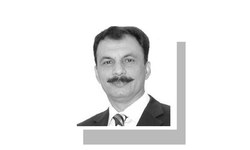|
The writer, Mohammad Ali Babakhel, is a police officer and represented Pakistan in the 2nd International Conference on Law Enforcement and Public Health in Amsterdam.
|
Read the original article here
THE continued attacks on polio vaccinators signify that eradication of polio is not only a public health concern but also a governance issue. According to AFP, at least 30 vaccinators and nearly 30 law enforcement personnel providing them security have lost their lives in such attacks since December 2012.
From January 2012 to September 2014, in Khyber Pakhtunkhwa, six policemen and eight polio workers were killed in 14 reported incidents. Security cover to polio workers is a major undertaking for law enforcement in this province because one round alone of a vaccination campaign in Peshawar requires the deployment of 4,592 policemen. Since 2012, in the first ever public health initiative by the police, KP’s Motorway Police has vaccinated thousands of children in transit. We need more initiatives along such lines.
The 2nd International Conference on Law Enforcement and Public Health in Amsterdam last October was an attempt to better integrate police into public health initiatives. Current challenges warrant redefining the role and responsibilities of the police, in which, apart from being crime fighters, human rights protectors, and combatants of terrorism, they are also expected to be public health protectors.
The reason for the expansion of the police’s role — which is in keeping with the concept of ‘social policing’ — is simple. It is the only visible institution with an understanding of socio-cultural dynamics on a local level and one that frequently interacts with the public.
Although Article 3 of the Police Order, 2002 already makes it incumbent upon police in Pakistan to help women, children and weaker segments of society, it should be interpreted in practical terms to make it relevant to current requirements. We need to integrate the boundaries between crime, health and welfare. In other words, bring the police out of isolation and effect partnerships between them and health departments, NGOs and rehabilitation centres.
We need to integrate the boundaries between crime, health and welfare.
Take the issue of drug addiction. The police needs to make a distinction between drug traffickers and addicts. In Pakistan, there are reportedly 6.7 million drug addicts, a majority of whom are between 25–39 years. Police performance is assessed on the basis of recovered quantity of narcotics and the number of addicts arrested, because drug addiction is treated as an issue of supply and demand.
Addicts primarily harm themselves, and therefore need psychiatric attention. The police needs to reduce their fear of persecution and thus devise communication strategies to deal with them. What the situation calls for is “harm reduction policing”, in which addicts are not treated as enemies of society.
Therefore, police performance should also be assessed on the basis of assistance extended and number of addicts referred to rehabilitation centres. However, there are no formal mechanisms of coordination between police and rehabilitation institutions in this country. To get to the root of the problem, the police needs to be an integral part of the rehabilitation process
Female police comprise only 1pc of the entire force. Increased induction of women will not only expand the role of the police in public health but also improve its overall image.
While public safety is the police’s exclusive operational domain, the term public safety must be more loosely interpreted so that they can play a role in improving road safety, and preventing child abuse and domestic violence. It is yet to be realised that domestic violence is not only a crime but also a public health issue. Police training should also cater for safety challenges confronted by the police while dealing with victims of crime, terrorism and road accidents.
The Amsterdam Declaration on Police Partnerships for Harm Reduction was signed on Oct 4, 2014. It recognises the importance of the need to develop sustained partnerships between police, other law enforcement agencies and people living with and affected by HIV and those providing care, treatment and support for them.
Public safety and health are a multi-faceted responsibility. That is why the HIV/Aids programmes in several countries include the police as an effective actor. In Kenya, Vietnam, Bangladesh, Thailand and Indonesia, police officers have in fact been tasked as focal persons in such programmes.
To ensure the well-being of vulnerable sections of society, drafting a code of ethics for the police is imperative. To improve its role in the domain of public health, the United Nations Office on Drugs and Crime, Pakistan drew up a code of ethics in 2013. Moreover, in order to develop better understanding between police and vulnerable communities, mass media, social media and traditional mediums should be used to the optimum extent.
Public health is social well-being tied to public safety and, by extension, to better policing. Effectiveness of the police should not be gauged on the basis of statistics alone but also assessed in the light of social services and public satisfaction.
The writer is a police officer and represented Pakistan in the 2nd International Conference on Law Enforcement and Public Health in Amsterdam.
Published in Dawn January 11th , 2014



